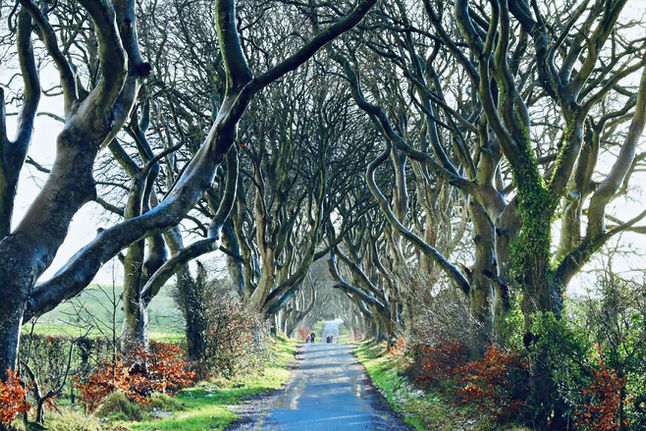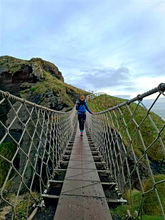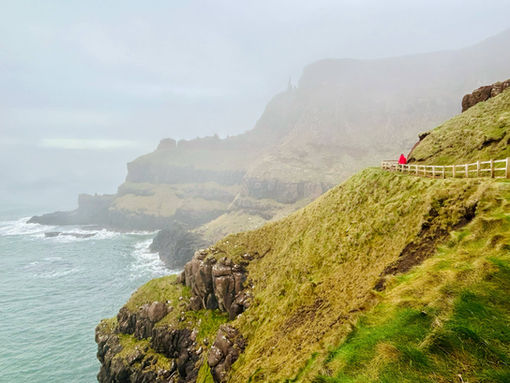Our 7-day itinerary
in the north of Ireland
Still amazed by our trip to Scotland the previous year, we decided to continue exploring the British Isles in the heart of winter, this time venturing to Northern Ireland. Between breathtaking landscapes, wild and contrasting nature, and a rich, poignant historical heritage, Northern Ireland revealed itself in all its beauty and complexity.
Just like the Scottish winter, the Irish one also has its charms: sometimes freezing and windy days, followed by evenings spent by the fire, and above all, authentic, heartfelt hospitality.
A winter getaway, full of contrasts and character.
Summary
Overview of our trip
Duration
7 days
Distance traveled
900 km
Time of year
December
Not to be missed
A guided tour of West Belfast, the Titanic Museum, climbing Mount Errigal and Glenveagh National Park (Republic of Ireland), a road trip along the Causeway Coastal Road (Whitepark Bay, Giant's Causeway, Carrick-a-rede, Dunluce Castle)
Our itinerary
Day 1: Discovering Belfast
We started our first day exploring the center of Belfast. The city center is compact and easy to discover in about an hour. Some highlights not to miss:
-
Ann Street, a charming cobbled street leading to the city’s “entries.” These narrow lanes, once Belfast’s main thoroughfares, now house bars, restaurants, and street art. Informational panels along the way tell their history.
-
The majestic City Hall, which, unfortunately, was closed to visitors during our stay.
-
St George’s Market, a must-visit for sampling local crafts and fresh produce.
Next, we immersed ourselves in the Titanic Museum, which transports visitors back to Belfast’s industrial era at the end of the 19th century and traces the construction of the Titanic (~€35 entry with audio guide). From iconic artifacts to recreated cabins and an immersive shipyard experience, the museum brings the story of the Titanic to life. The tragic sinking is told with great emotion, and the audio guide really enhances the visit. The ticket also includes access to the SS Nomadic, Titanic’s tender (optional in our point of view). With a quick lunch on site, two hours were enough to fully enjoy both attractions.
In the afternoon, we joined a guided tour of West Belfast, the area at the heart of the Troubles from 1960 to 1998. Through two very different perspectives, the tour delved into the complex history of the conflict. We first met a former Catholic republican prisoner, ex-IRA, who shared his experiences and his commitment to reconciliation. Then, we spoke with a Protestant loyalist, who offered his view of the events. Walking through both communities, we saw powerful murals, memorials, and the peace wall, which still closes every night—a stark reminder of the city’s ongoing divisions. This visit left a deep impression on us, and we highly recommend the tour, booked via Civitatis (€25 per person), for anyone wanting to understand the Troubles and their lasting impact on Belfast and its people.
Travel tip if you’re driving: Our accommodation was a few kilometers from the city center, and getting between neighborhoods by public transport seemed tricky, so we decided to drive. Here's a helpful resource with a list of Belfast car parks, including locations and rates.
Day 2: Game of Thrones Studios and Tollymore Forest
We started our second day with a visit to the Game of Thrones studios (~35€), located 35 minutes by car from Belfast. For 1 hour 45 minutes, we wandered through iconic sets, such as Castle Black, the grand halls of Dragonstone and Winterfell, and of course the famous Iron Throne room. Many costumes, props, and objects used during filming are on display, accompanied by detailed explanations of the techniques used, from special effects to staging. We chose to use the audio guide (~5€) on our phones, which added interesting behind the scenes stories and anecdoctes, making the visit even more engaging. In short, a great site for fans of the series.
We then continued our day with a walk in the Tollymore Forest, further south. This beautiful forest offers a variety of hiking trails suitable for all levels, ranging from 0.7 to 8.8 km (see map). Access is subject to a fee (~6€ per vehicle). We opted for the red trail (5.2 kms), an easy and pleasant walk across mostly flat terrain. The trail alternates between beech, birch, oak, and a dense pine forest. Note that the site closes early in winter (4 p.m.), so plan your visit accordingly.
Day 3: Hiking in the Mourne Mountains
For this third day, we had planned a hike connecting the peaks of Bearnagh and Meelmore, in the stunning Mourne Mountains. The starting point (here) is located near the Trassey Car Park. The trail begins on flat terrain with gentle incline, before becoming wilder and steeper as we approach the Hare's Gap col, dominated by an imposing stone wall stretching as far as the eye can see. From the col, violent gusts made the walk more challenging, but we decided to continue to the summit of Bearnagh. Despite the conditions slowing our progress, we finally reached the summit of Bearnagh, where a spectacular panorama unfolded before us. As visibility decreased and conditions became too risky, we opted for caution and descended by the same route rather than attempt the ascent of Meelmore. Apart from the unpredictable weather, we would rate the hike as moderate in difficulty: some rocky sections, some steep climbs, but breathtaking views in the heart of raw nature that make every step worthwhile.
After this adventure, we drove to Letterkenny (about 2.5-hours), in the Republic of Ireland, where we rented a cozy cottage for two nights. Please note : there are no border controls between Northern Ireland and the Republic of Ireland, so no special formalities are required. However, remember to inform your car rental agency, as additional coverage charges may apply.
Tips for the Bearnagh and Meelmore hike: check the weather forecast on the MET website before setting off, as conditions can be dangerous. Print out a route map to help you navigate (available on this website in English), since the trails are not well signposted.
Day 4: Ascent of Mount Errigal, walk in Glenveagh National Park
We spent our fourth day exploring County Donegal, in the Republic of Ireland, whose landscapes reminded us a lot of the Scottish Highlands.
We started the day by climbing Mount Errigal, the highest point in the region. As we gained altitude, the snow began to fall and soon blanketed the ground, creating a magical atmosphere. The moment was all the more memorable as Irish hikers we met on this January 1st greeted us with cheerful New Year's wishes. On the descent, a stunning panorama unfolded: surrounding peaks freshly dusted with snow, and below, the valley where lakes and winding roads meandered. With its spectacular landscapes and unique atmosphere, this hike was one of our favorites of the trip. At 5.2 kms long and 530 meters of elevation gain, it is demanding but well-marked. Given the conditions, it took us 2.5 hours round trip. The hike starts from a small parking lot at the base of the mountain.
We then made a brief detour to Dunlewey Church, an abandoned church nestled between a lake and the surrounding mountains. Despite its peaceful and somewhat mystical setting, it did not strike us as a must-see.
We continued our exploration of Donegal at Glenveagh National Park. The park offers several hiking trails, from 1 to 8 km. Some start from the car park, others from the castle, accessible on foot (3.5 kms) or by shuttle. On this January 1st, the shuttle was not operating, so we opted for the Derrylahan Nature Trail, a pretty, well-marked 2-km loop suitable for all. It winds through a variety of landscapes (pine forests, peat bogs) and offers beautiful views of the Glenveagh valley. We extended our walk along the lake towards the castle for a few kilometers before turning back, with the sun already beginning to set. The castle and its gardens, also closed that day, seem worth a visit on another trip.
Day 5: (London)Derry and Inishowen peninsula
We returned to Northern Ireland to explore Derry (or Londonderry), tragically known for the Bloody Sunday that happened in 1972, when the British army fired on a peaceful demonstration, killing 14 civilians. The city still bears the marks of the conflict between loyalists and nationalists, visible in the organization of its neighborhoods and through the numerous murals, particularly in the Bogside district below the old town, where the Bloody Sunday clashes took place. To gain a deeper understanding of the city's history, we began with a guided tour, booked via GetYourGuide (€10 + tip expected). We then strolled through the rooms of the Tower Museum (~€7 per person), which retrace the major stages of Derry's history, before visiting the town hall (the Guildhall, free), whose impressive architecture houses beautiful stained-glass windows. The old town, surrounded by well-preserved ramparts, can be explored on foot in about thirty minutes.
In the afternoon, we headed to the Inishowen Peninsula. Our first stop was Nancy's Barn, a restaurant famous for its chowder (fish soup), elected the best in the world in 2017. Verdict: an absolute treat! We then continued to Malin Head, the northernmost point of Ireland, for a walk along the cliffs, through the windswept moors, bathed in the golden light of late afternoon.
Day 6: The Dark Hedges, Bushmills Distillery and the Causeway Coastal Route
We started our first day in the north of the country at The Dark Hedges, a beech-lined avenue made famous by Game of Thrones. Usually very crowded in high season, the site was almost deserted during our visit. Was the €6 parking fee worth it? Not really in our opinion - perhaps only in spring or summer when the trees are in full leaf.
We then visited the Bushmills Distillery, the world's oldest licensed whisky distillery. The tour of the historic buildings and the whisky-making process was informative and concluded with a delightful tasting (visit at €40 for 1h30, several options are available, book in advance is required).
In the afternoon, we set off to explore the legendary Causeway Coastal Route, which winds along the country's north coast. Our first stop was Whitepark Bay Beach, where we initally planned a brief pause. We ended up staying over an hour, captivated by the beauty of the place and its sutnning, photogenic panoramas. We then continued to Ballycastle, a seaside village whose colorful main street is lined with shops and lively pubs. Some, like Nellie Rua's, offer live music on weekdays.
Day 7: Carrick-a-rede, the Giant's Causeway and the coastal fortresses
Our last day in Ireland was dedicated to exploring the iconic sites along the north coast. We took the Causeway Coastal Route again, this time at sunrise, marveling at the peaceful landscapes unfolding before us.
Our first stop was the ruins of Kinbane Castle (free). Built in the 16th century by the Scottish MacDonnell clan, the castle stands proudly on a small rocky peninsula. It’s accessible via a steep path and a few fairly steep steps in about ten minutes. Isolated, the site gives a true “end-of-the-world” feeling. Next, we headed to Carrick-a-Rede, famous for its rope bridge constructed in the 18th century by salmon fishermen to reach a rocky islet (originally made of ropes, it is now reinforced with steel cables). It takes about twenty minutes to reach from the parking area via a scenic cliffside path. The experience was impressive, especially since we were alone, allowing us to enjoy the bridge in complete tranquility! Tickets must be purchased online in advance (~€17).
We then made a short stop at the ruins of Dunseverick Castle (free), of which almost nothing remains. It’s not a must-see by itself, but the Dunseverick to Giant’s Causeway coastal trail, accessible from the parking area, offers beautiful viewpoints. Our next stop was Dunluce Castle (~€7). Perched on the edge of the cliffs, this medieval ruin is particularly photogenic and fairly well preserved. A small paper guide provided at the entrance allows visitors to immerse themselves in the history of the site and imagine life back then.
Finally, we ended the day at the Giant’s Causeway, a UNESCO World Heritage Site. Formed about 60 million years ago by a volcanic eruption, this astonishing geological formation consists of over 40,000 perfectly interlocking hexagonal basalt columns. Entry (€17) includes an audio guide combining scientific facts and local legends, including that of the giant Finn McCool. From the visitor center, we walked down to Giant’s Bay (about a fifteen-minute gentle slope) while listening to the site’s story. There is also a shuttle available for those with reduced mobility (€1). On site, we admired the iconic basalt columns rising out of the sea. Despite the crowds, the place remains impressive. We extended our visit along the coastal path to the amphitheater viewpoint, passing the Organ, an impressive vertical column formation resembling the pipes of a giant instrument. During our visit, the rest of the trail was closed due to landslides. This site is definitely worth a visit for its iconic nature, even if it wasn’t our personal favorite - the north of Ireland is full of wilder, equally magnificent, and far less crowded spots.
For our three nights in the north, we found a beautiful cottage, perfectly located for exploring the area. Ultra cozy, it comes with thoughtful touches of its hosts: a bottle of Prosecco, snacks, and everything needed for brunch were provided, along with a preheated hot tub upon our arrival. A true oasis of serenity!
Contact us
Follow us






































